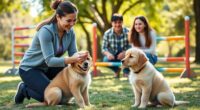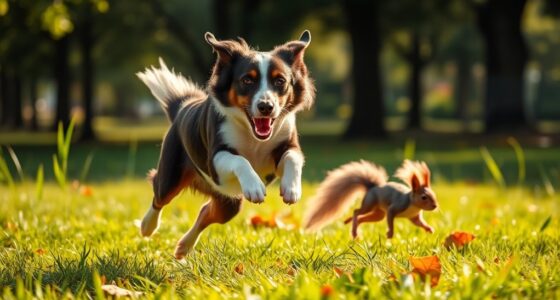To create a personalized training plan, start by evaluating your dog’s unique personality, behaviors, and needs. Observe how they react in different situations, note triggers, and identify what motivates them. Consider factors like age, breed, and health to choose appropriate methods. Focus on positive reinforcement and create a supportive environment to encourage learning. By understanding these details, you can develop effective strategies. Keep exploring to learn more ways to tailor your approach and achieve better results.
Key Takeaways
- Conduct comprehensive behavior evaluations across different situations to identify triggers, reactions, and learning preferences.
- Consider your dog’s age, breed, and health to tailor training methods and set realistic goals.
- Observe your dog’s responses to visual cues versus verbal commands to determine the most effective communication style.
- Use positive reinforcement consistently to encourage desired behaviors and foster a supportive learning environment.
- Adjust training environments to minimize distractions and optimize your dog’s comfort, promoting effective and enjoyable learning.

Have you ever wondered why generic training plans often fall short of your goals? The truth is, every dog is unique, with different personalities, learning styles, and needs. That’s why creating a customized training plan begins with thorough assessment. You need to understand what makes your dog tick, what challenges they face, and what motivates them. This isn’t about following a one-size-fits-all approach; it’s about tailoring your methods to suit your dog’s individual traits. When you start by evaluating their behavior, you can identify specific issues and strengths. For instance, if your dog tends to be anxious around new people, you’ll want a plan that gradually introduces socialization rather than overwhelming them. If they respond well to treats, positive reinforcement becomes a core element of your training strategy. Recognizing that positive reinforcement—rewarding desired behaviors—encourages your dog to repeat those behaviors is vital in this process. It’s a gentle, effective way to modify behavior without resorting to harsh corrections. Behavior modification, in this setting, involves systematically encouraging positive behaviors and minimizing unwanted ones through consistent, clear cues and rewards. When you assess your dog’s needs, you’re fundamentally laying the foundation for this approach. Additionally, understanding the importance of vibrational energy can help you create a more positive environment that supports your training efforts. To do this effectively, observe your dog in various situations, noting what triggers certain behaviors and what seems to calm or excite them. Keep a journal of their reactions to different stimuli. Are they easily distracted? Do they respond better to visual cues or verbal commands? Do they show signs of stress during specific activities? This information will help you pinpoint what training techniques will work best. It’s also essential to consider their age, breed, and health status, as these factors influence how quickly they learn and what methods are most effective. For example, a high-energy breed might require more physically demanding activities, while a calmer breed might benefit from mental exercises. Once you gather this data, you can set realistic goals and select the appropriate training tools and techniques. This personalized approach guarantees you’re addressing your dog’s specific needs, making training more effective and enjoyable for both of you. Ultimately, a tailored plan that incorporates positive reinforcement and behavior modification strategies will foster a stronger bond and promote lasting behavioral change.
Frequently Asked Questions
How Often Should I Update My Dog’s Training Plan?
You should update your dog’s training plan whenever you notice changes in behavior or progress. Regularly reassess to maintain training consistency and adapt reinforcement techniques as needed. If your dog masters commands quickly, introduce more advanced skills or increase difficulty. Conversely, if they struggle, revisit foundational training. Staying flexible guarantees your plan remains effective, keeping your dog engaged and motivated while strengthening your bond through ongoing, tailored training efforts.
Can I Adapt the Plan for Multiple Dogs?
Absolutely, you can adapt the plan for multiple dogs! Imagine tailoring a suit for each pup’s breed differences and age considerations—each one needs a unique fit. Some breeds might require more patience or specific commands, while age affects energy levels and learning pace. You’ll need to customize the training approach for each dog, ensuring all get the right guidance to thrive, no matter their size, breed, or age.
What Signs Indicate My Dog Needs a Different Approach?
If your dog shows behavioral signals like increased barking, withdrawal, or aggression, it might need a different approach. Environmental factors such as new surroundings or changes in routine can also affect their training needs. Pay close attention to these signs, and adjust your methods accordingly. Flexibility is key; if your current plan isn’t working, be ready to modify your techniques to better suit your dog’s evolving needs and environment.
How Do I Measure Progress Effectively?
You measure progress by tracking training milestones and behavior benchmarks regularly. Keep a journal to note improvements in commands, responsiveness, and behavior consistency. Use positive reinforcement to celebrate small wins and observe how your dog responds over time. If milestones aren’t being met or behaviors stall, it’s a sign to adjust your approach. Consistent evaluation helps you see clear progress and tailor your training to your dog’s evolving needs.
Should Training Plans Vary by Breed or Age?
Yes, your training plans should vary by breed differences and age considerations. Different breeds have unique temperaments and learning styles, so you’ll want to customize your approach accordingly. Similarly, age affects your dog’s attention span and energy levels, meaning young puppies need short, positive sessions, while adult dogs can handle more complex training. Adjusting your plan ensures effective progress and keeps your dog engaged and motivated.
Conclusion
Think of your dog’s training journey as tending to a garden. Each plant needs different care and attention to thrive. By creating a customized plan, you’re planting the seeds for a strong, trusting bond. With patience and dedication, you’ll nurture your dog’s unique personality and needs, allowing them to flourish. Remember, your consistent effort is the water that helps this garden grow into a beautiful, harmonious space where both of you can thrive together.









